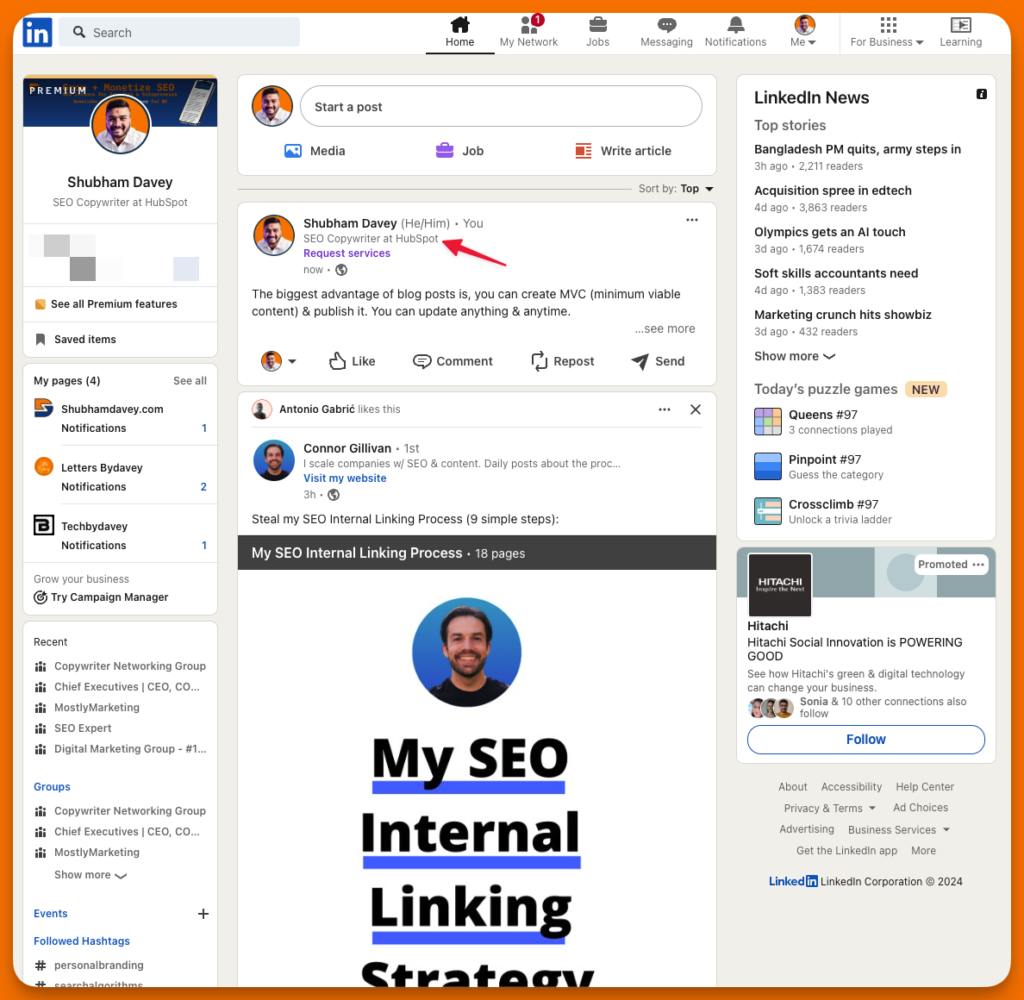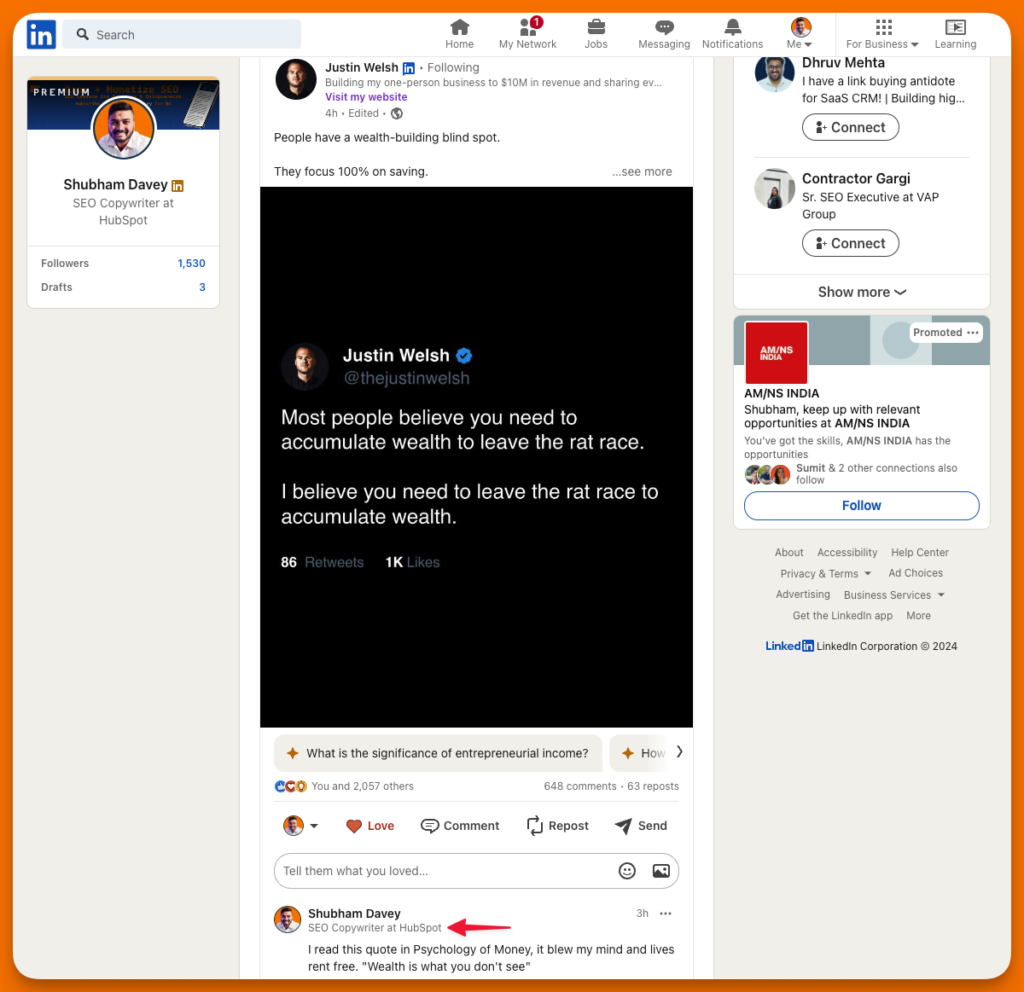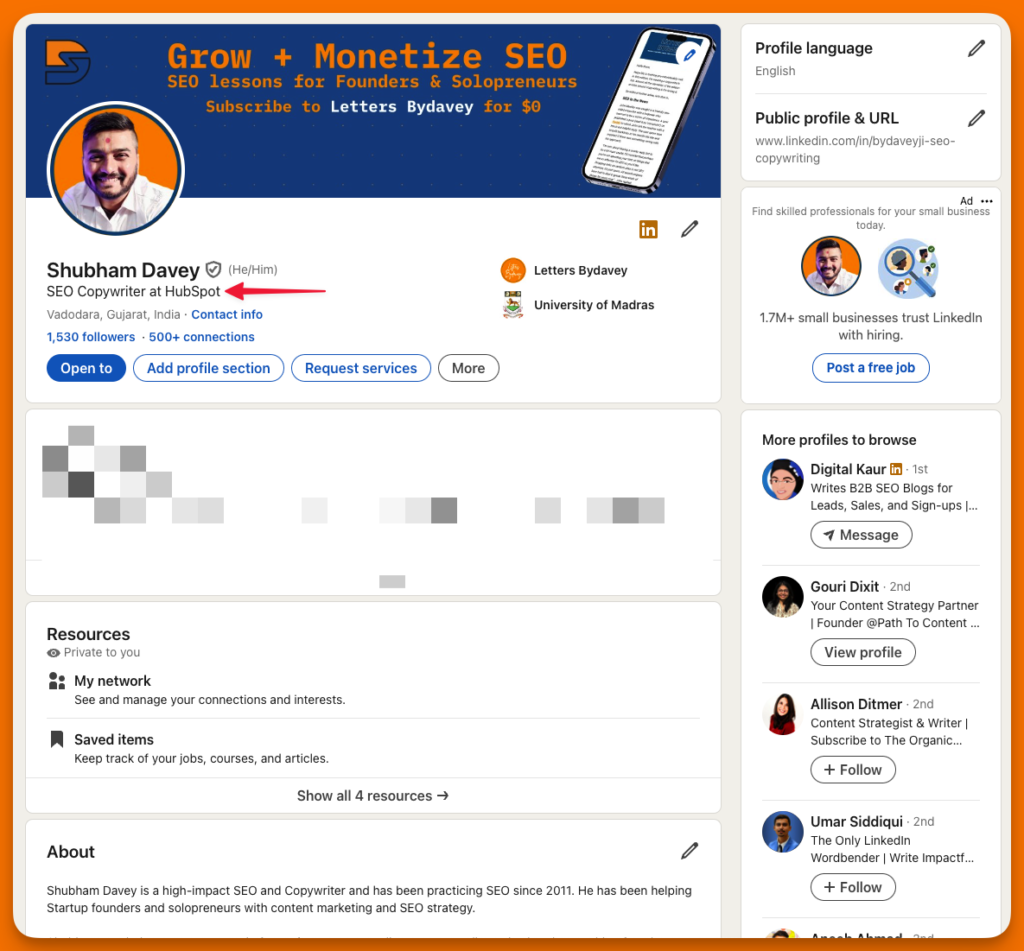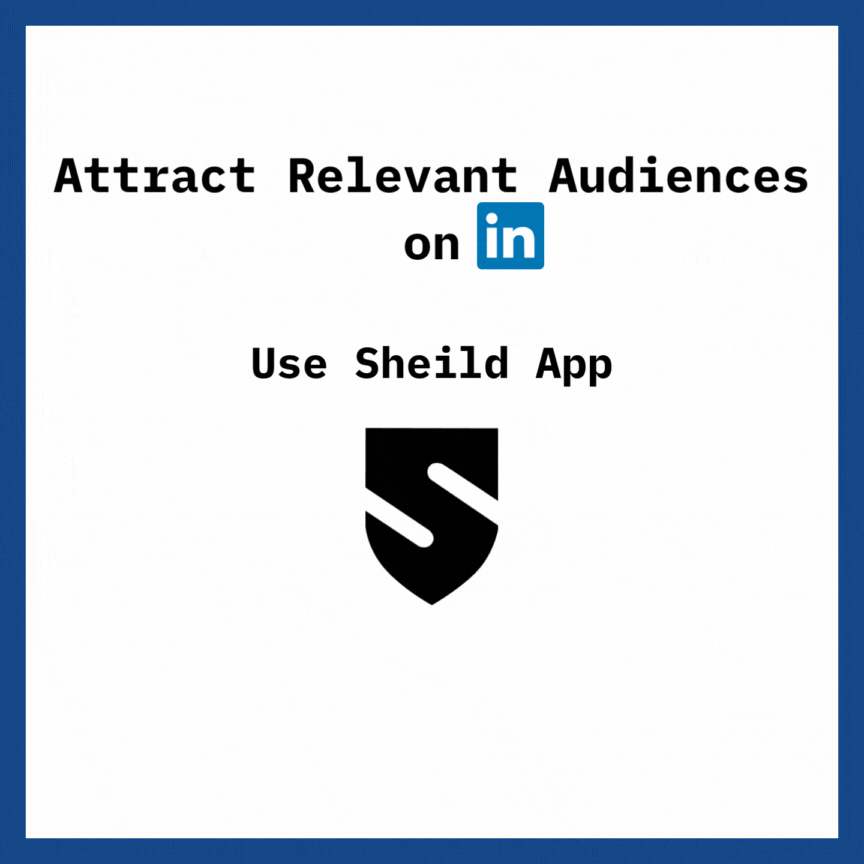1. LinkedIn is the best platform to generate B2B leads.
2. Understand top 3 elements of LinkedIn Profile Optimization to get exponential results.
3. Use my APPLE framework to optimize your LinkedIn profile & convert visitors into leads/customers.
LinkedIn was born for job seekers. I remember my elder brother introducing me to LinkedIn as “Facebook for professionals” back in 2011. I signed up and never used it until 2019-20. Now, in 2024, LinkedIn has become a huge platform for businesses, founders, solopreneurs, freelancers and job seekers.
Finding leads for B2B, B2C, and D2C has become super easy with the explosion of users on the platform. The fundamental of lead generation on any such platform is “being found” when people search for people like you.
If you’re a business owner (founder, solopreneur, freelancer), this post will help you optimize your LinkedIn profile in a way that generates more leads.
I’m not going to talk about the same techniques that are covered to death on the internet already. I’m going to focus on the three most important elements that bring the maximum results.
Let’s dive in.
Why bother with LinkedIn? Is LinkedIn profile optimization worth it?
The buying rules have changed. A lot of decision-makers have made their way to LinkedIn, and they’re just a DM away.
If you’re a B2B brand and not active on LinkedIn, you’re leaving a lot of money on the table.
If you’re a freelancer, your potential clients are already searching on LinkedIn to hire good people.
If you’re a business owner or a founder, your potential customers are spending a lot of time on LinkedIn.
You should optimize your profile beforehand so that when you create content & drive users to your profile, you can convert them into leads and customers or at least for brand awareness.
Once your profile is optimized, you can step up to grow your reach using this Linkedin growth strategy I personally use. This has changed how I use LinkedIn to my benefit. I network with unicorn founders, I generate leads, I reach out to decision makers of potential customer businesses and do a ton of things.
The most important elements of LinkedIn Profile Optimization
I’ve been actively using LinkedIn since 2019.
One reason why I love LinkedIn is that my headline is visible everywhere.
#1 On my LinkedIn feed, on my posts,

#2 In the comments section of other’s posts,

#3 and, of course, on my profile.

I’ve used that real estate to promote my newsletter and my services. Depending on the need of the hour, I switch my headline. When I have enough work, I promote my newsletter in the headlines. Otherwise, I promote my services to attract inbound leads.
Spend most of your time optimizing your headline. Your headline should include your skills & credibility. It should reflect what you do & who will benefit from it.
Make sure you don’t make it too long, as the full headline might get trimmed.
The headline is your space to attract users to your profile, which should be optimized for conversions beforehand.
The whole point of creating content on LinkedIn is to attract users to your profile and convert them to your desired goals.
I use the APPLE framework to convert profile visitors using my optimized LinkedIn profile. This approach aims to attract users through content, entice them with a compelling headline, and convert them once they land on your profile.
This framework incorporates all three elements that I think are the most important and have the biggest impact on results.
The three elements are the Headline, About section & Experience section. Out of the three, the headline is the most important.
The conversion will happen only when the potential customer lands on your profile, and the headline is the only weapon you have that can bring users from the feed to your profile.
APPLE Framework for LinkedIn Profile Optimization:
- A – Attract with Authority
- P – Personalize Your Pitch
- P – Prove Your Worth
- L – Lead with Value
- E – Engage Strategically
Let me explain this framework.
#1 Attract with Authority
Your headline is your first impression. It needs to grab attention and establish your expertise quickly.
- Ditch generic headlines. Instead of “Founder at XYZ Company,” try “Helping SaaS startups scale to 7 figures | Growth Strategist”
- Use powerful words that resonate with your target audience. Words like “expert,” “specialist,” or “innovator” can work wonders
- Include your unique selling proposition (USP). What makes you different from others in your field?
Example: “Tech Visionary | Turning Startups into Industry Leaders | 3x Successful Exits”
#2 Personalize Your Pitch
Your “About” section is where you get to tell your story. Make it count.
- Start with a hook. Something like, “I’ve helped 50+ startups go from idea to IPO.”
- Share your journey. People connect with stories, not just achievements
- Address your ideal client’s pain points. Show them you understand their challenges
- End with a clear call to action. What do you want profile visitors to do next?
#3 Prove Your Worth
Use your experience section to showcase results, not just responsibilities.
- Highlight key achievements with numbers. “Increased client retention by 40% in 6 months”
- Include case studies or success stories. Real examples carry more weight than vague claims
- Don’t just list skills. Show how you’ve applied them to solve real-world problems
#4 Lead with Value
Your content strategy should focus on providing value to your target audience.
- Share insights from your experience. What have you learned that others could benefit from?
- Create how-to posts or videos. Teaching builds trust and positions you as an expert
- Comment thoughtfully on industry trends. Show you’re on top of what’s happening in your field
#5 Engage Strategically
Build relationships, don’t just grow connections.
- Respond to comments on your posts. Start conversations, not monologues
- Join relevant groups and contribute meaningfully. Don’t just self-promote
- Reach out to potential leads with personalized messages. No copy-paste job here
This isn’t about gaming the system. It’s about clearly communicating your value to the right people. Your optimized profile sets the stage, but it’s your consistent value-adding content that’ll keep drawing people in.
If you follow my APPLE framework, you’re not just optimizing for LinkedIn search. You’re creating a profile that converts visitors into leads, clients, or whatever your goal might be. It’s about making that first impression count and then backing it up with substance.
Optimizing LinkedIn profile for growth
Once you optimize your profile, it’s time to grow your LinkedIn profile. There are two ways to attract users to your profile: Comments and content creation.
#1 Creating
Content creation on LinkedIn is difficult. It takes a lot of trial and error, even with a proven strategy. There’s a lot that goes into creating content on LinkedIn:
- Deciding a niche
- Picking up content categories you want to touch upon,
- Setting goals
- Creating reusable templates for faster content creation
- Learning everything about the audience
- Dealing with negative feedback and improving
- Adapting to algorithmic changes
- …. and whatnot
If you’re just starting out, don’t focus too much on content creation. Start with 1 post a week and comment the rest of the time.
Speaking of comments, that’s our second type of content creation.
#2 Commenting
Every time I’m unable to post on LinkedIn, I comment. And I comment a lot. The comments should be so valuable that there’s a standalone post in itself.
Commenting is an art in itself. Commenting like everyone else and expecting different results than everyone else is insanity at its best.
Here’s a masterclass on the art of commenting by Jasmin Alić.

What’s tracked will grow. To track your growth, consider using the Sheid App. Businesses like Rolls Royce use the Shield App to grow on LinkedIn.
Best way to promote yourself on LinkedIn
What’s the use of an optimized LinkedIn profile when you’re not actively using the platform? You should be promoting your products/services on LinkedIn, attracting people to your profile and converting to meet your goals.
Let’s cut through the fluff and talk about promoting yourself on LinkedIn without sounding like a robot or rehashing the same old advice:
- Ditch the boring job title: Instead of “Marketing Manager at XYZ Corp,” try something like “I help startups get their first 1000 customers | Marketing wizard.” It’s more eye-catching and tells people what you actually do.
- Share war stories, not just wins: Don’t just brag about your successes. Talk about the times you messed up and what you learned. For example, “That time I accidentally sent an email blast to our entire database… and how we turned it into our best campaign ever.”
- Be a human, not a resume: Your “About” section shouldn’t read like a list of accomplishments. Tell a story about why you do what you do. Maybe you got into tech because you were terrible at sports and found solace in coding. People remember stories, not bullet points.
- Comment like you mean it: Don’t just say, “Great post!” Add something valuable. If someone posts about a marketing trend, share a quick example of how you’ve seen it work (or fail) in real life.
- Create content that actually helps people: Instead of vague “thought leadership,” give practical advice. If you’re in sales, share your exact email template that gets responses. People love stuff they can use right away.
- Use video (even if you hate how you look on camera): Record a quick 60-second tip related to your industry. It doesn’t have to be polished. In fact, a bit of “realness” can make you more relatable.
- Ask for help (yes, really): People love feeling useful. Post something like, “I’m trying to improve my public speaking. What’s one tip that’s helped you?” You’ll get engagement and maybe even make some connections.
- Share other people’s stuff (and tell them why): Find a post you love, share it, and explain why it resonated with you. Tag the original poster. It’s a great way to network without being pushy.
- Use LinkedIn’s features, but don’t go overboard: Try things like polls or LinkedIn Live, but don’t use every single feature just because it’s there. Pick what works for your style and audience.
- Be consistent, but don’t stress about it: Post regularly, but don’t kill yourself trying to post every day if it’s not sustainable. Quality beats quantity every time.
Ready to dominate LinkedIn?
While growing on LinkedIn is difficult, it’s still easier than other platforms. Especially considering the fact that only 1% of all users actively create content on LinkedIn.
It’s not about being perfect; it’s about being you, which helps build a distinctive personal brand. Don’t stress about creating a world-class brand, at least not in the beginning. You need 1000 true fans. That’s it. Optimizing your LinkedIn profile is a great start to getting your 1000 true fans.
Know someone who can use this information? Share this post with them & share it on your social network as well.

